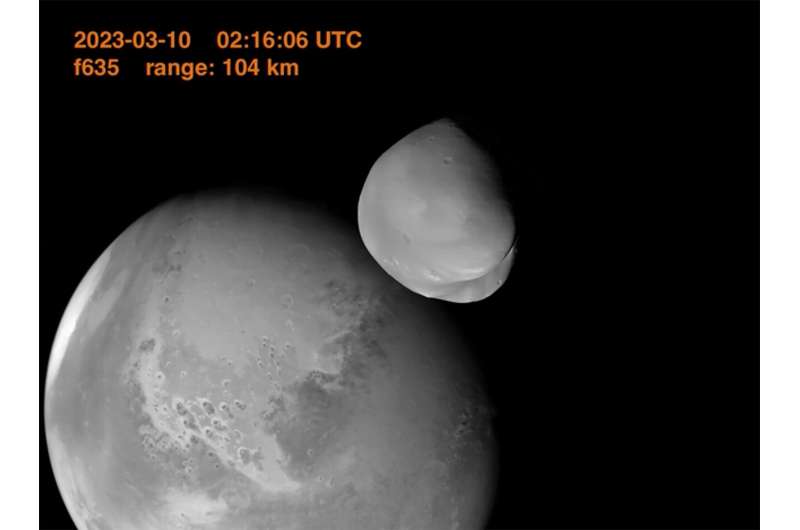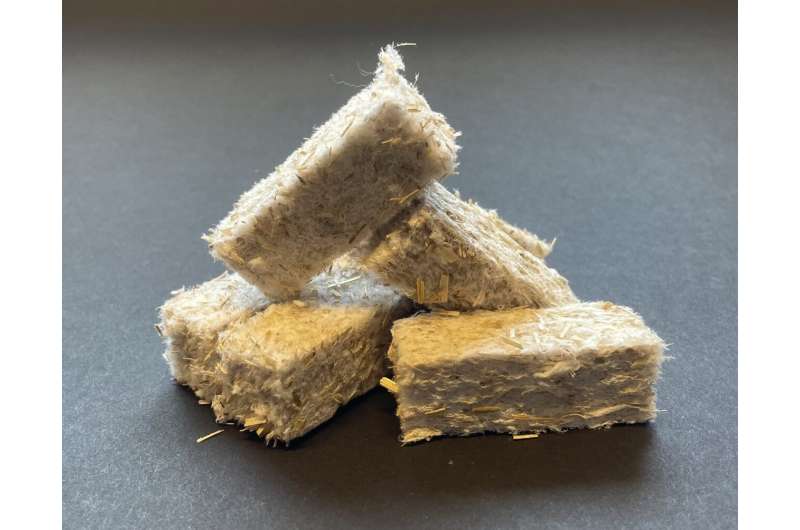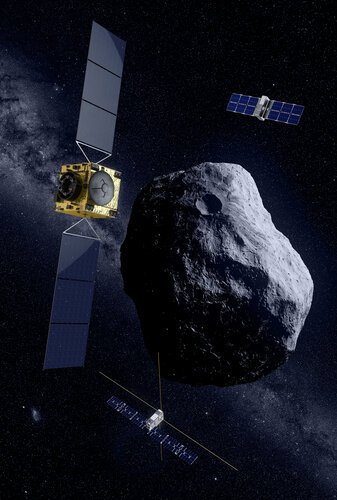
Copernical Team
UAE spacecraft takes close-up photos of Mars' little moon

A spacecraft around Mars has sent back the most detailed photos yet of the red planet's little moon.
The United Arab Emirates' Amal spacecraft flew within 62 miles (100 kilometers) of Deimos last month and the close-up shots were released Monday. Amal—Arabic for Hope—got a two-for-one when Mars photobombed some of the images.
Cultivating salad plants that can be grown on the Moon

NASA has finished its planning and is ready to go. Humans will soon be returning to the Moon—this time in a manned base. But, if this project is to succeed, astronauts must be able to grow their own food. Norwegian researchers are in the process of making this possible.
The lunar "soil," or regolith as geologists call it, is essentially a powder in which it is difficult to grow plants. As if this wasn't enough, the moon is characterized by temperatures that can reach 200 degrees during the day and fall to as low as minus 183 degrees at night.
So says SINTEF researcher Galina Simonsen. However, in spite of this, Simonsen and her colleagues working as part of the international project LunarPlant, which is being headed by NTNU Social Research and the Center for Interdisciplinary Research in Space (CIRiS), believe that it will be possible to grow food plants on the moon.
Is sex in space being taken seriously by the emerging space tourism sector?

What would a human conception in space mean for the sector? That's the situation posed by an international group of scientists, clinicians and other interested parties, who have authored a consultative green paper led by David Cullen, Professor of Astrobiology & Space Biotechnology at Cranfield University.
It highlights that the emerging space tourism sector has not openly considered or discussed the risks of sex in space or prepared suitable mitigation approaches. It argues it is unrealistic to assume all future space tourists will abstain from sexual activities—opening the possibility of human conception and the early stages of human reproduction occurring in space.
This appears to pose several risks, those of a biological nature such as embryo developmental risks and those of a commercial nature such as liability, litigation, and reputational damage. The authors recommend that an open discussion is now needed within the space tourism industry to consider the risks.
Open discussion on human conception in space tourism is lacking
Professor Cullen from Cranfield University led the work. He said, "Our starting point was a throwaway comment about sex in space, but when we checked, we were surprised the sector has not openly considered the risks and this led to the study.
What colour is an asteroid? Hyperspectral imager to find out

What colour is an asteroid? The latest instrument being prepared for ESA’s Hera mission for planetary defence will observe its target Dimorphos asteroid in a range of colours far beyond the limits of the human eye. In the process Hera’s HyperScout H hyperspectral imager will help prospect the asteroid’s mineral makeup – in the process helping to deduce how best to deflect future asteroids which might one day endanger Earth.
Defying gravity
 Surely it has ever happened to you to shake an open bag of mixed nuts. Have you noticed that after such a procedure, the largest nuts in the mixture - Brazil nuts - float to the top? The phenomenon of large objects rising to the surface of a mixture of small objects, bearing the professional name of granular convection, is popularly referred to "the Brazil nut effect" and occurs commonly in natu
Surely it has ever happened to you to shake an open bag of mixed nuts. Have you noticed that after such a procedure, the largest nuts in the mixture - Brazil nuts - float to the top? The phenomenon of large objects rising to the surface of a mixture of small objects, bearing the professional name of granular convection, is popularly referred to "the Brazil nut effect" and occurs commonly in natu Starship moves fast and breaks things
 Flying chunks of concrete, twisted metal sheets, craters blasted deep into the ground: the thunderous power of SpaceX's first test flight of Starship - the biggest and most powerful rocket ever built - inflicted serious damage on its Texas launch site.
Repairing the damage from Thursday's unmanned test flight is expected to take months, potentially delaying further launch attempts and slow
Flying chunks of concrete, twisted metal sheets, craters blasted deep into the ground: the thunderous power of SpaceX's first test flight of Starship - the biggest and most powerful rocket ever built - inflicted serious damage on its Texas launch site.
Repairing the damage from Thursday's unmanned test flight is expected to take months, potentially delaying further launch attempts and slow Potential Failure Modes of SpaceX's Starship
 On April 20, 2023, a little after 9:30 A.M. eastern time SpaceX's new Starship system lifted off from the company's southeast Texas spaceport. This was an historic event because the Starship is the largest and most powerful rocket ever built. The ship ascended smoothly for the first several minutes, but as the vehicle approached the moment of stage separation an anomaly occurred that resulted in
On April 20, 2023, a little after 9:30 A.M. eastern time SpaceX's new Starship system lifted off from the company's southeast Texas spaceport. This was an historic event because the Starship is the largest and most powerful rocket ever built. The ship ascended smoothly for the first several minutes, but as the vehicle approached the moment of stage separation an anomaly occurred that resulted in Webb reveals primordial galaxy cluster 650 million years after the Big Bang
 Every giant was once a baby, though you may never have seen them at that stage of their development. NASA's James Webb Space Telescope has begun to shed light on formative years in the history of the universe that have thus far been beyond reach: the formation and assembly of galaxies. For the first time, a protocluster of seven galaxies has been confirmed at a distance that astronomers refer to
Every giant was once a baby, though you may never have seen them at that stage of their development. NASA's James Webb Space Telescope has begun to shed light on formative years in the history of the universe that have thus far been beyond reach: the formation and assembly of galaxies. For the first time, a protocluster of seven galaxies has been confirmed at a distance that astronomers refer to China's space missions break new ground
 Lunar samples, mineral discovery and experience for future missions among gains Chinese scientists have made major advances in the research of Earth's nearest celestial neighbor, the moon, thanks to samples and data gathered by China's lunar probes.
In the latest development, water locked in glass beads has been found in lunar samples returned by the Chang'e 5 mission.
A study publis
Lunar samples, mineral discovery and experience for future missions among gains Chinese scientists have made major advances in the research of Earth's nearest celestial neighbor, the moon, thanks to samples and data gathered by China's lunar probes.
In the latest development, water locked in glass beads has been found in lunar samples returned by the Chang'e 5 mission.
A study publis Five ways open science is transforming NASA research and protecting our planet
 In celebration of Earth Day, it's important to recognize the role of open science in protecting our planet and advancing NASA's research efforts. Through initiatives like NASA's Transform to Open Science (TOPS), researchers can collaborate and share data, promoting transparency and scientific integrity.
By sharing research findings and data publicly, NASA is enabling scientists and the pub
In celebration of Earth Day, it's important to recognize the role of open science in protecting our planet and advancing NASA's research efforts. Through initiatives like NASA's Transform to Open Science (TOPS), researchers can collaborate and share data, promoting transparency and scientific integrity.
By sharing research findings and data publicly, NASA is enabling scientists and the pub 
